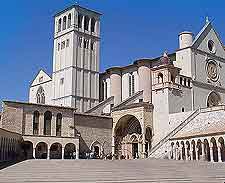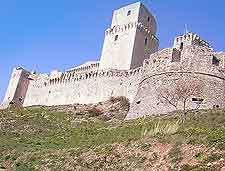Assisi History Facts and Timeline
(Assisi, Umbria, Italy)

Assisi's history is thought to have begun in 1,000 BC, when it is believed to have first grown up as an Umbrian settlement.
After the Battle of Sentinum, which took place at the end of the 3rd century BC, Roman forces prevailed. As a Roman colony, Assisi was known as Asisium. There's evidence of a pagan temple in the town's Piazza del Commune, which dates to the 1st century BC.
One of Assisi's most famous Romans was a poet called Sextus Propertius, who was born here in 55 BC. In the early 3rd century, the town was visited by St. Rufino, who attempted to bring Christianity here. It was to be the start of a close association between the town and religion.
From the Middle Ages On
In 1182, Giovanni Francesco di Bernardone was born in Assisi. Whilst he was to live most of his life in a state of poverty, he actually was born into a fairly well-off merchant family. As Francis, he founded a Franciscan community, which was finally officially sanctioned by Pope Innocent III in 1210. There's evidence that around 1224, he received the stigmata. Canonized in 1228, he became known as St. Francis.
The Basilica di San Francesco was built as a final resting place for the saint's bones. It was also a place where some of Assisi's most treasured works of art were housed. The Basilica di Santa Chiara was built to remember another of Siena's saints, known as St. Clare. It is little wonder that throughout history,
Siena has been a popular place of pilgrimage.
Medieval Assisi soon outgrew the boundaries established by its former Roman masters. Throughout the Middle Ages, Assisi found itself caught up in internal rivalry. At different times in its history, the town fell under the control of various factions. In the end, the town decided to support the Ghibellines, who favoured the Holy Roman Empire, as opposed to the Papacy.

Modern History
In the early 1500s, Assisi did once again come under the control of the Papacy. Papal control lasted until 1464. Thereafter, the town seems to have enjoyed a period of relative stability. As is often the case, peace brought a measure of prosperity. This was a time in Assisi's history when new buildings sprang up all over the town, including its many 'palazzi'. Finally, in 1860, the town became part of the newly created Kingdom of Italy.
In 1997, Assisi was struck by violent earthquakes. Its famous Basilica di San Francesco was damaged, while several frescoes in the basilica's vault were destroyed. Thanks to some rather rapid conservation work, it has largely been returned to its former glory, reopening to the public just two years after the event. Today, Assisi is the next most important of Italy's pilgrimate sites next to
Rome.
 Assisi's history is thought to have begun in 1,000 BC, when it is believed to have first grown up as an Umbrian settlement.
Assisi's history is thought to have begun in 1,000 BC, when it is believed to have first grown up as an Umbrian settlement.